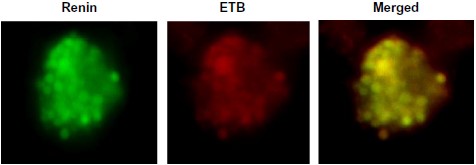Overview
- Peptide CEMLRKKSGMQIALND, corresponding to amino acid residues 298-314 of rat ET-B (Accession P21451). 3rd intracellular loop.
- Rat brain membranes (1:200).
 Western blot analysis of rat brain membranes:1. Anti-Endothelin Receptor B Antibody (#AER-002), (1:200).
Western blot analysis of rat brain membranes:1. Anti-Endothelin Receptor B Antibody (#AER-002), (1:200).
2. Anti-Endothelin Receptor B Antibody, preincubated with Endothelin Receptor B Blocking Peptide (#BLP-ER002).
- Rat brain sections and rat lung paraffin embedded section (1:100). Mouse retina (1:100) (Rattner, A. and Nathans, J. (2005) J. Neurosci. 25, 4540.).
- Human endocardial endothelial cells (EECs) (1:100) (Jacques, D. et al. (2005) Peptides 26, 1427.).
Endothelins (ET-1, 2, and 3) are considered to be very powerful vasoconstrictive substances. In humans, endothelins mediate their actions via two specific G-protein coupled receptors, ETAR and ETBR. Both ETAR and ETBR are present in the heart and in human myocardium at similar levels.1,2
The endothelin receptors differ in their ligand specificity. While ETAR has varying affinities for the endothelin isoforms (ET-1 > ET-2 > ET-3), ETBR shows no selective affinity.2,3
Subsequent studies have demonstrated the presence of endothelins in vascular, as well as in non-vascular, cells and tissues, having multiple biological activities.
Currently, there is increasing evidence that ET-1 may modulate mitogenesis, apoptosis, angiogenesis tumor invasion and the development of metastases.3
Until recently, it was thought that all cellular activities of the endothelins were mediated through their interactions with their cell surface receptors. However, a recent study demonstrated that cardiac nuclei also possess both ETAR and ETBR subtypes, which are functional and coupled to signaling mechanisms within the nuclear membrane.2
Hypermethylation of the ETBR correlated with transcriptional down-regulation and reduced expression of ETB receptor was observed in several prostate, bladder and colon cancer cell lines.3
Application key:
Species reactivity key:

Expression of Endothelin Receptor B in mouse JG cells.Immunocytochemical staining of mouse isolated juxtaglomerular (JG) cells using Anti-Endothelin Receptor B Antibody (#AER-002), (red). ET-B staining co-localizes with renin, a kidney cell marker, (green).Adapted from Ortiz-Capisano, M.C. (2014) Physiol. Rep. 2, e12240. with permission of the American Physiological Society and The Physiological Society.
